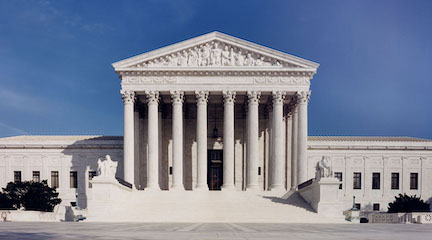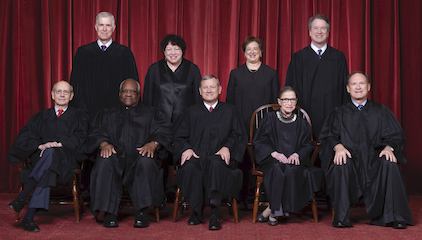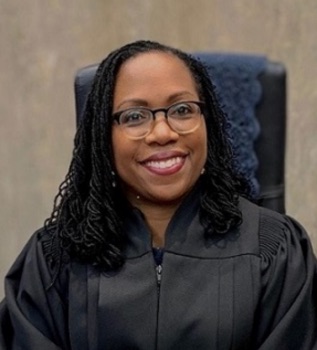 |
A Vacancy on the Court | < |
The Breyer VacancyThe Breyer Vacancy
Birth: August 15, 1938 Justice Stephen Breyer has been under intense pressure from Democrats to retire in order to permit Presiden Biden to name a replacement prior to the 2022 midterm election while the Democrats still have a 51-50 advantage in a 50-50 split Senate, thanks to the Vice President's tie-breaking authority. The Republicans have bested the Democrats at just about every turn on Supreme Court appointments. When Obama was presented a vacancy in early 2016, the Republican-controlled Senate commenced a record-breaking refusal to even consider Obama's nomination of Merrick Garland. When Justice Ginsburg died in September of 2020, the Republicans set a modern-day speed record in confirming President Trump's nomination of Amy Coney Barrett, giving the Republicans a super-majority of six conservative justices on the Court. Assuming a successful confirmation of a Biden nominee, the balance on the Court remains the same, but renewing Breyer's seat with a younger justice buys Democrats some time. It may be a while before seeing another vacancy. Only two justices are over 70 years of age—Thomas and Alito, born in 1948 and 1950, respectively. Initially passed over by President Clinton in favor of Ruth Ginsburg, Breyer was subsequently nominated in 1994 to fill the vacancy created by Justice Harry Blackmun. All Democratic senators and all but nine Republicans voted to confirm the nomination, the last time that a nominee would have opposition in only the single digits. An extensive assessment of Justice Breyer’s career and his jurisprudence may be found in the CQ Press Supreme Court Collection http://library.cqpress.com/scc/document.php?id=bioenc-427-18975-1014168&v=06a2c351d460bd41 Breyer has written and spoken extensively regarding constitutional and statutory interpretation. I like his Yale Lectures published in the 2011 Yale Law Journal under the title of “Making Democracy Work.” It’s available at https://digitalcommons.law.yale.edu/ylj/vol120/iss8/2. In addition to a succinct critique of originalism (pp. 2013-14), Breyer asserts that statutory and presumably constitutional interpretation involves looking “to text, to history, to tradition, to precedent, to statutory purposes, and to the effects (of deciding one way or another) viewed in light of those purposes,” the latter two being most useful (p.2016). In this context, an example of Breyer jurisprudence at work is his dissent in the campaign finance case of McCutcheon v. FEC (2014) and also in D.C. v. Heller (2008). You can easily find biographies and other legal analyses on Breyer. We are more concerned on this site with what his vacancy means for the Court and for the appointment process. For decades, the Court has relative definable voting blocs on cases involving issues that produce different ideological perspectives. Conservative and liberal divisions are quite clear in about 20-25% of the cases heard by the Court as represented by 5-4 decisions, now 6-3 with Barrett's replacement of Ginsburg. In the 2020/21 term, 14 of 18 such cases were decided by the conservative bloc. The SettingIt’s a different world from when Justice Breyer was confirmed in 1994. Back in the day, a qualified nominee picked to replace a departing justice deemed to be similar in jurisprudential and constitutional perspective would be largely accepted by the opposition party. In the twenty-first century, that is no longer the case. Nominations now provide grist for the partisan ideological mills regardless of qualifications or whether the nominee is perceived as having a strong impact on the direction of the Court. Breyer’s replacement, for the most part, will simply refresh what is perceived as one of three liberal voices on the Court. Biden reaffirmed that he intended to nominate a Black woman, and there were a number who met the generally recognized qualifications for a Supreme Court justice. The Republican mill immediately attacked Biden’s pledge as unconstitutional affirmative action, playing the race card to further divide the nation. There’s a certain irony here, Republican presidents having seized opportunities to appoint the first woman to the Court (Reagan appointing O’Connor, having pledged in advance to appoint a woman) and to replace the first and only Black person on the Court, Thurgood Marshall, with a conservative Black man (Bush appointing Thomas), who has served as the antithesis of Marshall, and most recently seeking out a woman who could serve as the antithesis of Justice Ginsburg (Trump appointing Barrett). The choice of Barrett at least provided someone with relatively strong credentials. In 1980, though, qualified conservative women were in short supply, but on the strength of recommendations from Justice Rehnquist and Arizona Senator Barry Goldwater, O’Connor emerged from national obscurity to the Supreme Court. The appointment of Clarence Thomas had everything to do with his being Black, having arguably the thinnest set of credentials among a number of potential nominees, including four Hispanic men, two women, and two white men. It seems likely that Republicans on the Judiciary Committee will take the lead in criticizing the liberal credentials of the nominee, pursuing the role of negative partisan (See the page on the Senate Judiciary Committee.) and trotting out the tried and tired rhetoric of liberal activism and the lack of fidelity to the Constitution. Her experience in the public defender's office will likely produce rhetoric that she is soft on crime, although an easy response to that is that she is strong on the Constitution, ensuring the constitutional rights of the accused, more often than not the indigent, are protected. A full blown, well-funded opposition is less likely, although advocacy groups do use these nominations for fund raising and rallying the faithful. The support of all Democrats is expected, and that is all that is needed. Some Republican support is likely, though probably not much. The Nominee
From the beginning, Ketanji Brown Jackson (born September 17, 1970 in D.C.) was the front-runner among the various Black women highlighted as potential nominees for the Breyer vacancy. After all, she was already on the short list in 2016 when President Obama nominated Merrick Garland. She might even have seemed fated for the position from her high school years, moving on through a Harvard undergraduate degree (AB, magna cum laude, 1992), Harvard Law degree (JD, cum laude, 1996), and a clerkship with Justice Stephen Breyer, the justice she would some day replace. She has worked in various private law firms, while her public service is notable, first with the U.S. Sentencing Commission as assistance special counsel from 2003-2005 and then again as vice chair from 2010 to 2014. In between she worked in the federal public defender's office from 2005-2007. Brown Jackson was appointed to the DC District Court in 2013 and elevated to the DC Circuit Court in June 2021 by President Biden and a 53-44 confirmation vote in the Senate. All 50 Democrats and three Republicans (Collins-ME, Murkowski-AK, Graham-SC) voted to confirm. It's easy to find biographical and judicial information online for Jackson. The two below are particularly good.
The InterimThe interim period is that time between the nomination and the vote in the Senate. It encompasses public reaction to the nomination, the activities of advocacy groups, press coverage, as well as the Senate Judiciary Committee hearing and subsequent committee activity. Use the links on the left to inform yourself about these various aspects of the process. What typically happens next for a nominee is a number of visitations to Senate leaders and members of the Senate Judiciary Committee. Simultaneously, the Judiciary Committee has the nominee complete a comprehensive questionnaire, and each senator on the committee will either assign a staff member to compile an independent file on the nominee or agree to work together with another one or more other senators to gather information in preparation for the hearing. A background check by the FBI is also standard procedure for such nominations. This is the time when the White House will marshall its resources to secure a variety of endorsements for the nominee. Early on, the Fraternal Order of Police issued a strongly worded endorsement, noting the various family ties she has to police forces. Various conservative voices from judges and others with ties back to the Reagan and both Bush administrations have voiced support for her confirmation. Republican leadership in the Senate, including McConnell and Grassley have acknowledged her qualifications. Some Republicans will decide this nomination is not worth substantial opposition. Nothing in this appointment will affect the current ideological split on the Court, and with control of the Senate at stake in the 2022 November election, they should not want to give the Democrats an issue that might escalate turnout among Blacks, women, and other potential Democratic voters. Last update: March 3, 2022 |